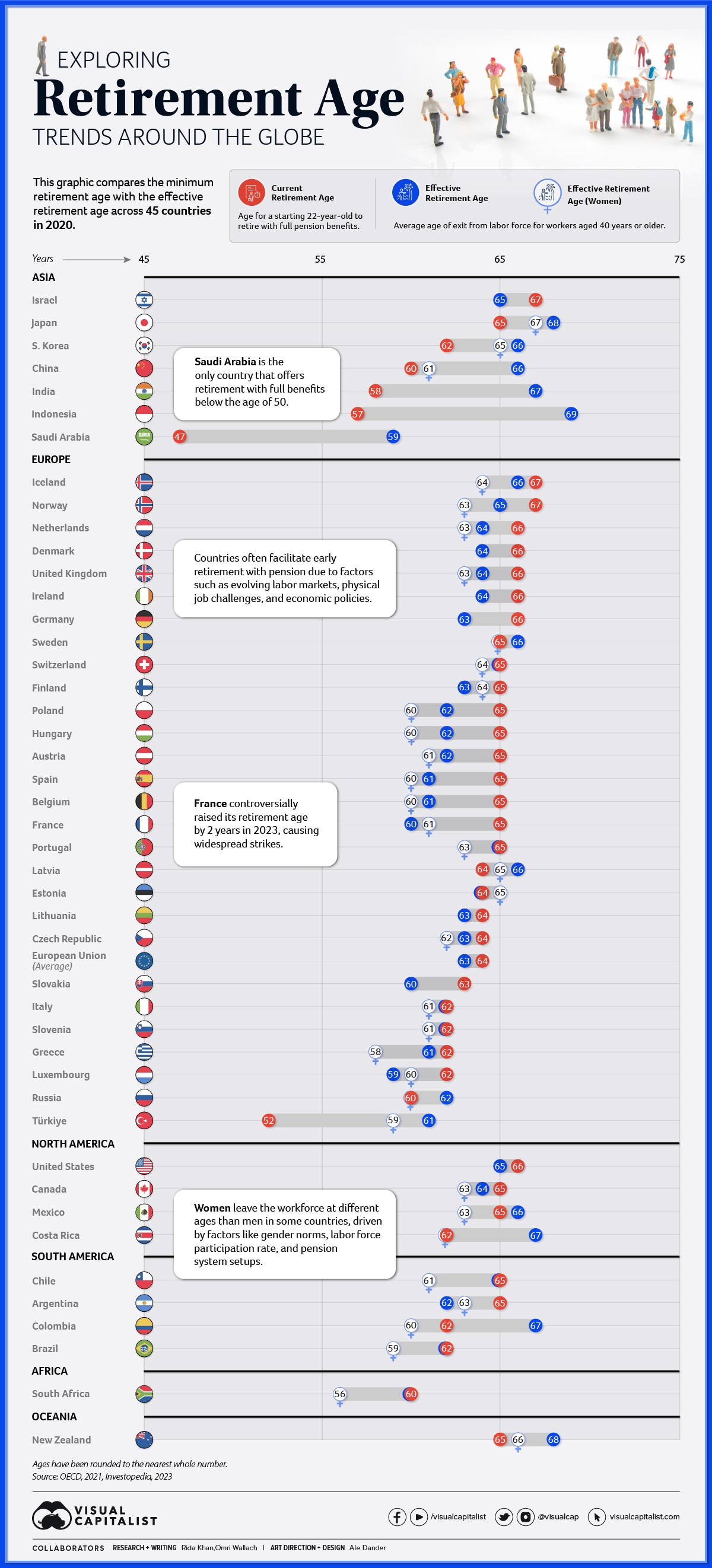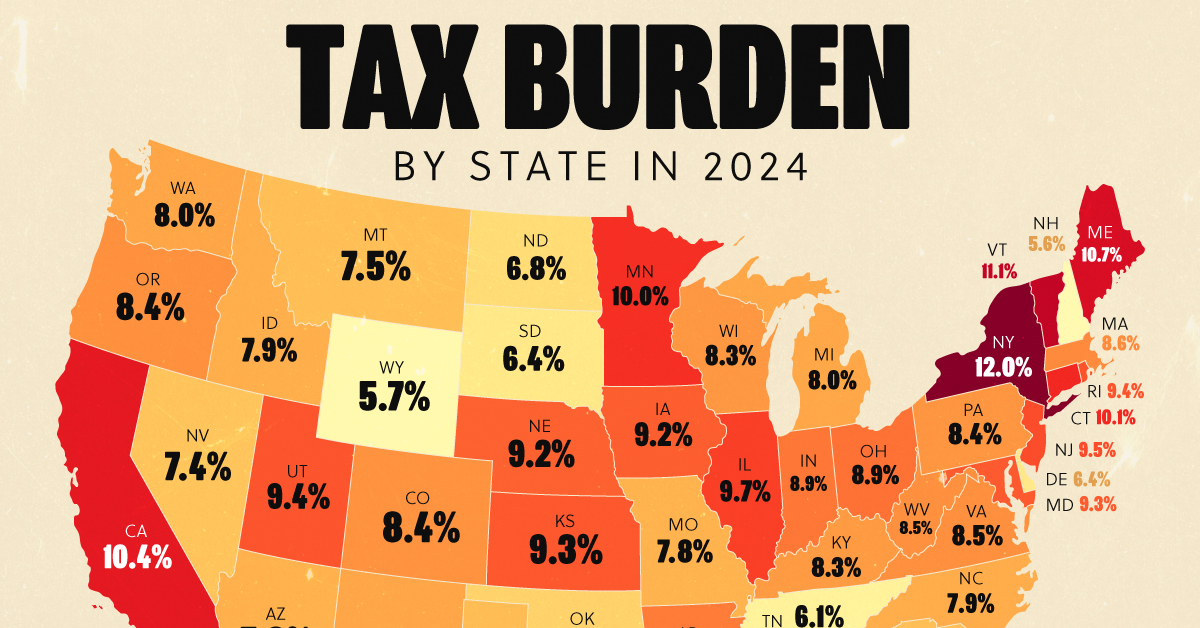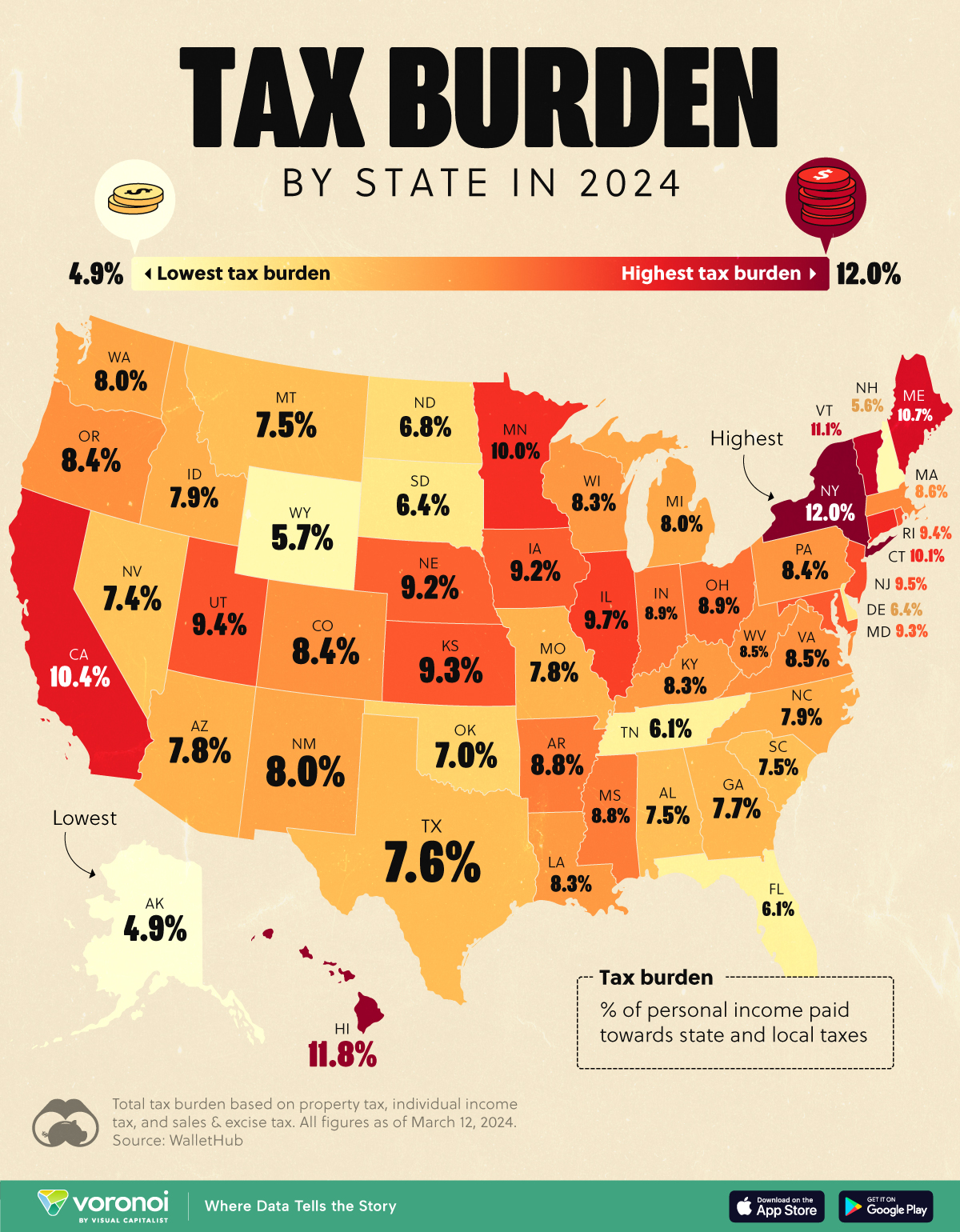Personal Finance
Charted: Retirement Age by Country

Charted: Retirement Age by Country
The retirement landscape can look completely different depending on what country you’re in. And charting the retirement age by country reveals a lot of differences in the the makeup of a labor force, both for economic and cultural reasons.
This graphic delves into the current and effective retirement ages across 45 nations in 2020, based on comprehensive data from the OECD 2021 report.
Defining Retirement Ages
Before we dive into the numbers, let’s clarify the measurements used by the Organisation for Economic Co-operation and Development (OECD):
- The current retirement age is the age at which individuals can retire without penalty to pension after completing a full career starting from age 22.
- The effective retirement age refers to the average age of exit from the labor force for workers aged 40 years or more.
Many countries have seen workers effectively retire earlier or later than the current retirement age. This variance can arise due to a multitude in factors including differences in career start ages, some industries offering earlier retirements or benefits for later commitments, or countries facilitating different workforce exits due to market demands and policies.
Some people also choose to retire early due to personal reasons or a lack of available work, receiving a smaller pension or in some cases forgoing it entirely. Likewise, some people choose to stay employed if they are able to find work.
Retirement Age by Country in 2020
Here’s a snapshot of the current and effective retirement ages by country in 2020:
| Country | Retirement age (Current) | Retirement age (Effective) | Retirement age (Women, Effective) |
|---|---|---|---|
| 🇦🇹 Austria | 65 | 62 | 61 |
| 🇧🇪 Belgium | 65 | 61 | 60 |
| 🇨🇦 Canada | 65 | 64 | 63 |
| 🇨🇱 Chile | 65 | 65 | 61 |
| 🇨🇴 Colombia | 62 | 67 | 60 |
| 🇨🇷 Costa Rica | 62 | 67 | 62 |
| 🇨🇿 Czech Republic | 64 | 63 | 62 |
| 🇩🇰 Denmark | 66 | 64 | N/A |
| 🇪🇪 Estonia | 64 | 64 | 65 |
| 🇫🇮 Finland | 65 | 63 | 64 |
| 🇫🇷 France | 65 | 60 | 61 |
| 🇩🇪 Germany | 66 | 63 | N/A |
| 🇬🇷 Greece | 62 | 61 | 58 |
| 🇭🇺 Hungary | 65 | 62 | 60 |
| 🇮🇸 Iceland | 67 | 66 | 64 |
| 🇮🇪 Ireland | 66 | 64 | N/A |
| 🇮🇱 Israel | 67 | 65 | N/A |
| 🇮🇹 Italy | 62 | 62 | 61 |
| 🇯🇵 Japan | 65 | 68 | 67 |
| 🇰🇷 Korea, Republic of | 62 | 66 | 65 |
| 🇱🇻 Latvia | 64 | 66 | 65 |
| 🇱🇹 Lithuania | 64 | 63 | N/A |
| 🇱🇺 Luxembourg | 62 | 59 | 60 |
| 🇲🇽 Mexico | 65 | 66 | 63 |
| 🇳🇱 Netherlands | 66 | 64 | 63 |
| 🇳🇿 New Zealand | 65 | 68 | 66 |
| 🇳🇴 Norway | 67 | 65 | 63 |
| 🇵🇱 Poland | 65 | 62 | 60 |
| 🇵🇹 Portugal | 65 | 65 | 63 |
| 🇸🇰 Slovakia | 63 | 60 | N/A |
| 🇸🇮 Slovenia | 62 | 62 | 61 |
| 🇪🇸 Spain | 65 | 61 | 60 |
| 🇸🇪 Sweden | 65 | 66 | 65 |
| 🇨🇭 Switzerland | 65 | 65 | 64 |
| 🇹🇷 Türkiye | 52 | 61 | 59 |
| 🇬🇧 United Kingdom | 66 | 64 | 63 |
| 🇺🇸 United States | 66 | 65 | N/A |
| 🇪🇺 European Union (Average) | 64 | 63 | N/A |
| 🇦🇷 Argentina | 65 | 62 | 63 |
| 🇧🇷 Brazil | 62 | 62 | 59 |
| 🇨🇳 China (People's Republic of) | 60 | 66 | 61 |
| 🇮🇳 India | 58 | 67 | N/A |
| 🇮🇩 Indonesia | 57 | 69 | N/A |
| 🇷🇺 Russia | 62 | 62 | 60 |
| 🇸🇦 Saudi Arabia | 47 | 59 | N/A |
| 🇿🇦 South Africa | 60 | 60 | 56 |
Three countries had the highest current retirement age at 67 years, Iceland, Israel, and Norway, but all had slightly lower effective retirement ages on average. On the flip side, Saudi Arabia had the lowest current retirement age at only 47 years with full pension benefits. Only Türkiye at 52 years was close, and notably both had much higher effective retirement ages on average.
Discrepancies between different regions are clear across the board. Many Asian countries including China, India, and South Korea have official minimum retirement ages in the early 60s and late 50s, but see workers stay in the workforce well into their late 60s. Meanwhile, most European countries as well as the U.S. and Canada have more workers retire earlier than minimum retirement ages on average.
Almost all of the countries with measured effective retirement ages for women also saw them exit the workforce earlier than men. This can be the result of cultural gender norms, labor force participation rates, and even the setup of pension systems in different countries.
The five exceptions in the dataset where women retired later than men? Argentina, Estonia, Finland, France, and Luxembourg.
Looking to the Future
In 2023, France sparked controversy by raising its early retirement age by two years. This decision triggered widespread strikes and riots and ignited debates about the balance between economic sustainability and individual well-being.
Given aging demographics in many developed countries and a continued need for labor, this isn’t expected to be the only country to reassess retirement. The OECD projects a two-year increase in the average effective retirement age by the mid-2060s.
Wealth
Visualizing the Tax Burden of Every U.S. State
Tax burden measures the percent of an individual’s income that is paid towards taxes. See where it’s the highest by state in this graphic.

Visualizing the Tax Burden of Every U.S. State
This was originally posted on our Voronoi app. Download the app for free on iOS or Android and discover incredible data-driven charts from a variety of trusted sources.
This map graphic visualizes the total tax burden in each U.S. state as of March 2024, based on figures compiled by WalletHub.
It’s important to understand that under this methodology, the tax burden measures the percent of an average person’s income that is paid towards state and local taxes. It considers property taxes, income taxes, and sales & excise tax.
Data and Methodology
The figures we used to create this graphic are listed in the table below.
| State | Total Tax Burden |
|---|---|
| New York | 12.0% |
| Hawaii | 11.8% |
| Vermont | 11.1% |
| Maine | 10.7% |
| California | 10.4% |
| Connecticut | 10.1% |
| Minnesota | 10.0% |
| Illinois | 9.7% |
| New Jersey | 9.5% |
| Rhode Island | 9.4% |
| Utah | 9.4% |
| Kansas | 9.3% |
| Maryland | 9.3% |
| Iowa | 9.2% |
| Nebraska | 9.2% |
| Ohio | 8.9% |
| Indiana | 8.9% |
| Arkansas | 8.8% |
| Mississippi | 8.8% |
| Massachusetts | 8.6% |
| Virginia | 8.5% |
| West Virginia | 8.5% |
| Oregon | 8.4% |
| Colorado | 8.4% |
| Pennsylvania | 8.4% |
| Wisconsin | 8.3% |
| Louisiana | 8.3% |
| Kentucky | 8.3% |
| Washington | 8.0% |
| New Mexico | 8.0% |
| Michigan | 8.0% |
| North Carolina | 7.9% |
| Idaho | 7.9% |
| Arizona | 7.8% |
| Missouri | 7.8% |
| Georgia | 7.7% |
| Texas | 7.6% |
| Alabama | 7.5% |
| Montana | 7.5% |
| South Carolina | 7.5% |
| Nevada | 7.4% |
| Oklahoma | 7.0% |
| North Dakota | 6.8% |
| South Dakota | 6.4% |
| Delaware | 6.4% |
| Tennessee | 6.1% |
| Florida | 6.1% |
| Wyoming | 5.7% |
| New Hampshire | 5.6% |
| Alaska | 4.9% |
From this data we can see that New York has the highest total tax burden. Residents in this state will pay, on average, 12% of their income to state and local governments.
Breaking this down into its three components, the average New Yorker pays 4.6% of their income on income taxes, 4.4% on property taxes, and 3% in sales & excise taxes.
At the other end of the spectrum, Alaska has the lowest tax burden of any state, equaling 4.9% of income. This is partly due to the fact that Alaskans do not pay state income tax.
Hate Paying Taxes?
In addition to Alaska, there are several other U.S. states that don’t charge income taxes. These are: Florida, Nevada, South Dakota, Tennessee, Texas, Washington, and Wyoming.
It’s also worth noting that New Hampshire does not have a regular income tax, but does charge a flat 4% on interest and dividend income according to the Tax Foundation.
Learn More About Taxation From Visual Capitalist
If you enjoyed this post, be sure to check out this graphic which ranks the countries with the lowest corporate tax rates, from 1980 to today.
-

 Markets5 days ago
Markets5 days agoVisualizing Global Inflation Forecasts (2024-2026)
-

 Green2 weeks ago
Green2 weeks agoThe Carbon Footprint of Major Travel Methods
-

 United States2 weeks ago
United States2 weeks agoVisualizing the Most Common Pets in the U.S.
-

 Culture2 weeks ago
Culture2 weeks agoThe World’s Top Media Franchises by All-Time Revenue
-

 voronoi1 week ago
voronoi1 week agoBest Visualizations of April on the Voronoi App
-

 Wealth1 week ago
Wealth1 week agoCharted: Which Country Has the Most Billionaires in 2024?
-

 Business1 week ago
Business1 week agoThe Top Private Equity Firms by Country
-

 Markets1 week ago
Markets1 week agoThe Best U.S. Companies to Work for According to LinkedIn














